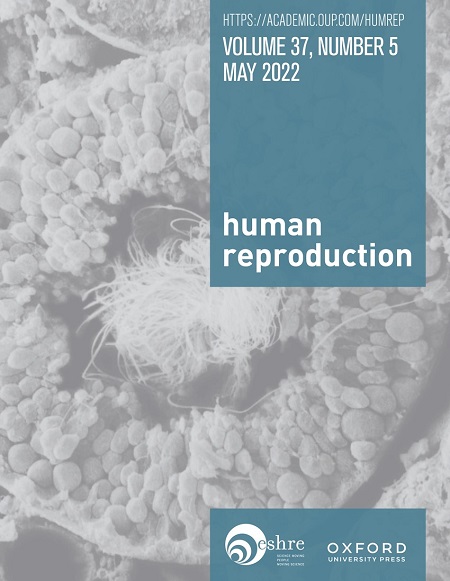调节性T细胞过继转移抑制调节性T细胞缺失小鼠子宫内膜异位症样病变的进展
IF 6
1区 医学
Q1 OBSTETRICS & GYNECOLOGY
引用次数: 0
摘要
研究问题:调节性T细胞(Tregs)的恢复是否抑制子宫内膜异位症的进展?过继性转移Tregs可抑制子宫内膜异位症的进展,降低小鼠辅助性T (Th)细胞相关和促炎细胞因子的水平。子宫内膜异位症是一种慢性炎症性妇科疾病,涉及多种免疫成分。激活的Treg计数在子宫内膜异位症患者的子宫内膜和子宫内膜中减少,Treg的消耗加剧了小鼠子宫内膜异位症。研究设计、大小、持续时间我们评估了过继性Tregs移植对小鼠子宫内膜异位症进展的影响。我们用Foxp3tm3Ayr/J (Foxp3DTR)小鼠,通过注射白喉毒素暂时切除Tregs,建立子宫内膜异位症模型,该模型通过卵巢切除、雌二醇给药和移植供鼠子宫碎片产生。将Foxp3DTR小鼠随机分为Treg过继转移组(n = 12)和对照组(n = 11)。从野生型(WT)小鼠的淋巴结和脾脏中分离treg,并过养转移到暂时缺乏treg的小鼠体内。对照组小鼠注射载药。在子宫着床当天进行Treg过继移植,14天后进行第二次过继移植。小鼠在子宫植入28天后安乐死,并收集血液、腹膜液、脾脏和子宫内膜异位症样病变样本。实验对象/材料、环境、方法向Foxp3DTR小鼠静脉注射WT小鼠分离的Tregs。子宫碎片植入后第28天评估子宫内膜异位症样病变的数量、总重量和总体积。流式细胞术分析Tregs在子宫内膜异位症样病变、腹水和外周血中的比例。采用实时荧光定量PCR和酶联免疫吸附法检测病变及血清炎症。主要结果及作用:随机注射使Tregs的总数量增加,使Tregs的数量减少(P <;0.0001)、体重(P = 0.0021)和体积(P = 0.0010)在Foxp3DTR treg缺失小鼠中的子宫内膜异位症样病变。此外,注射Tregs降低了Foxp3DTR treg缺失小鼠子宫内膜异位症样病变中th1 -、2-和17相关细胞因子的mRNA表达,包括干扰素γ (P = 0.0101)、白细胞介素(IL)-4 (P = 0.0051)和IL-17 (P = 0.0177),以及促炎细胞因子IL-6的水平(P = 0.0002)。大规模数据。局限性,谨慎的理由小鼠中treg相关的免疫机制可能不能准确反映人类。研究结果的更广泛意义在Treg数量减少是加剧因素的情况下,恢复Treg可能是抑制子宫内膜异位症进展的有用治疗策略。研究经费/竞争利益(S)本研究部分由日本教育、文化、体育、科学和技术省的科学研究援助补助金(资助号18K16808和20K22983)支持。在研究的设计、数据的收集、分析和解释、报告的撰写以及文章是否发表的决定中,主办方没有任何作用。作者没有需要披露的利益冲突。本文章由计算机程序翻译,如有差异,请以英文原文为准。
Adoptive transfer of regulatory T cells inhibits the progression of endometriosis-like lesions in regulatory T-cell-depleted mice
STUDY QUESTION Does the restoration of regulatory T cells (Tregs) suppress the progression of endometriosis? SUMMARY ANSWER Adoptive transfer of Tregs suppresses the progression of endometriosis and reduces the levels of helper T (Th)-cell-related and proinflammatory cytokines in mice. WHAT IS KNOWN ALREADY Endometriosis is a chronic inflammatory gynecological disease, which involves multiple immune components. Activated Treg counts decrease in the endometrioma and endometrium of patients with endometriosis, and depletion of Tregs exacerbates endometriosis in mice. STUDY DESIGN, SIZE, DURATION We evaluated the effects of adoptive transfer of Tregs on the progression of endometriosis in mice. We used Foxp3tm3Ayr/J (Foxp3DTR) mice with temporarily ablated Tregs by injecting diphtheria toxin to develop an endometriosis model, which was generated by ovariectomy, estradiol administration and transplantation of uterine fragments from donor mice. Foxp3DTR mice were randomly divided into Treg adoptive transfer (n = 12) and control (n = 11) groups. Tregs were isolated from lymph nodes and spleens of wild-type (WT) mice and were adoptively transferred into mice that were temporarily Treg-depleted. Control mice were injected with vehicle. Treg adoptive transfer was performed on the day of uterine implantation, and a second adoptive transfer was performed after 14 days. Mice were euthanized 28 days after uterine implantation, and blood, peritoneal fluid, spleen, and endometriosis-like lesion samples were collected. PARTICIPANTS/MATERIALS, SETTING, METHODS Foxp3DTR mice were intravenously injected with Tregs isolated from WT mice. The number, total weight, and total volume of the endometriosis-like lesions were evaluated on Day 28 following implantation of uterine fragments. The proportion of Tregs in endometriosis-like lesions, ascites, and peripheral blood was analyzed by flow cytometry. Inflammation in lesions and serum was examined using real-time PCR and ELISA. MAIN RESULTS AND THE ROLE OF CHANCE Injection of Tregs increased their total count and decreased the number (P < 0.0001), weight (P = 0.0021), and volume (P = 0.0010) of endometriosis-like lesions in Foxp3DTR Treg-depleted mice. Furthermore, injection of Tregs decreased the mRNA expression of Th 1-, 2-, and 17-related cytokines, including interferon gamma (P = 0.0101), interleukin (IL)-4 (P = 0.0051), and IL-17 (P = 0.0177), as well as the levels of the proinflammatory cytokine IL-6 (P = 0.0002), in endometriosis-like lesions of Foxp3DTR Treg-depleted mice. LARGE SCALE DATA N/A. LIMITATIONS, REASONS FOR CAUTION Treg-related immune mechanisms in mice may not precisely reflect those in humans. WIDER IMPLICATIONS OF THE FINDINGS Restoration of Tregs may be a useful therapeutic strategy for inhibiting the progression of endometriosis in cases where the decrease in the Treg population is an exacerbating factor. STUDY FUNDING/COMPETING INTEREST(S) This study was partially supported by the Grants-in-Aid for Scientific Research (grant numbers 18K16808 and 20K22983) from the Ministry of Education, Culture, Sports, Science, and Technology, Japan. The sponsor had no role in the study design, collection, analysis and interpretation of data, writing of the report, and decision to submit the article for publication. The authors have no conflicts of interest to disclose.
求助全文
通过发布文献求助,成功后即可免费获取论文全文。
去求助
来源期刊

Human reproduction
医学-妇产科学
CiteScore
10.90
自引率
6.60%
发文量
1369
审稿时长
1 months
期刊介绍:
Human Reproduction features full-length, peer-reviewed papers reporting original research, concise clinical case reports, as well as opinions and debates on topical issues.
Papers published cover the clinical science and medical aspects of reproductive physiology, pathology and endocrinology; including andrology, gonad function, gametogenesis, fertilization, embryo development, implantation, early pregnancy, genetics, genetic diagnosis, oncology, infectious disease, surgery, contraception, infertility treatment, psychology, ethics and social issues.
 求助内容:
求助内容: 应助结果提醒方式:
应助结果提醒方式:


